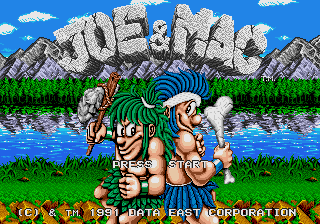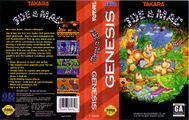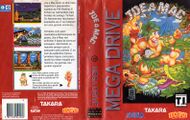Difference between revisions of "Joe & Mac"
From Sega Retro
m (Text replacement - "Krisalis/Shaun Hollingworth" to "Krisalis sound driver") |
|||
| Line 4: | Line 4: | ||
| developer=[[Eden Entertainment Software]]/[[Elite Systems]] | | developer=[[Eden Entertainment Software]]/[[Elite Systems]] | ||
| system=[[Sega Mega Drive]] | | system=[[Sega Mega Drive]] | ||
| − | | sounddriver=[[Krisalis]] | + | | sounddriver=[[Krisalis sound driver]] |
| peripherals= | | peripherals= | ||
| players=1-2 | | players=1-2 | ||
Revision as of 13:39, 20 January 2019
| Joe & Mac | |||||||||||||||
|---|---|---|---|---|---|---|---|---|---|---|---|---|---|---|---|
| System(s): Sega Mega Drive | |||||||||||||||
| Publisher: Takara | |||||||||||||||
| Developer: Eden Entertainment Software/Elite Systems | |||||||||||||||
| Original system(s): Arcade boards | |||||||||||||||
| Developer(s) of original games: Data East | |||||||||||||||
| Sound driver: Krisalis sound driver | |||||||||||||||
| Genre: Action | |||||||||||||||
| Number of players: 1-2 | |||||||||||||||
| |||||||||||||||
This short article is in need of work. You can help Sega Retro by adding to it.
Joe & Mac, known as Joe & Mac: Caveman Ninja in Europe and Joe & Mac: Caveman Fight (ジョーとマック 戦え原始人) in Japan, is a 1991 platforming action game by Data East, initially released for a DE-manufactured arcade board, but later ported to home computers and consoles such as the Super NES, NES, Game Boy and the Sega Mega Drive. Data East themselves produced the SNES version, while the rest of home versions were created by Elite Systems thanks to a conversion license granted by Data East, including the Mega Drive version which was developed by Eden Entertainment Software in late 1993. Publishing licenses of this version were granted to Takara in North America, TecToy in Brazil and Codemasters in Europe. While the game was released in North America and Brazil in early 1994, the European version never materialized.
Contents
Gameplay
You control Joe, a green-haired caveman, as he tries to rescue his and his blue-haired friend Mac's girlfriends, who have been kidnapped by enemy cavemen one night. Joe shoots a weapon by hitting ![]() ; he can change the particular weapon by grabbing a new one when it appears, but hold to much causes damage for recoil (hammers and wheels, for example).
; he can change the particular weapon by grabbing a new one when it appears, but hold to much causes damage for recoil (hammers and wheels, for example). ![]() and
and ![]() both jump, however
both jump, however ![]() makes Joe jump higher and curled into a ball;
makes Joe jump higher and curled into a ball; ![]() is a shorter jump that can be used to crush enemies.
is a shorter jump that can be used to crush enemies.
There is also a 2 player mode that let the second player control Mac; while most ports use a menu at the title screen to select the mode, the Mega Drive version requires you to hit START with the second controller at the title screen to play in 2 player mode.
Versions
On the Mega Drive, Joe & Mac is a no-frills arcade conversion, and while some of the graphics have been simplified, the game remains broadly the same. Its Super NES counterpart, on the other hand, is an expansion over the arcade game, featuring longer levels and more content, and a map screen not dissimilar to that of Super Mario World. The core gameplay remains identical between all versions, however.
In the arcades, Joe & Mac operates with an internal screen resolution of 256x240, which is then expanded horizontally to fill a 4:3 display. As the resulting pixels would not be square, the art assets are drawn "thin", with normal dimensions being resolved when displayed on-screen.
This is convinent for the Super NES version of Joe & Mac as its internal resolution is 256x224 (meaning the horizontal expansion is roughly the same), however this Mega Drive version operates with a native resolution of 320x224, causing almost every graphic in the game to appear too thin as the assets were not re-drawn. A side effect to this approach is that more of the play area is visible at any one time than in either the arcade or Super NES versions.
Production credits
- Written by: Tim Round
- Additional Code: Jason Stoat, Stuart Middleton
- Graphics by: Tim Round, Terry Baker, Stuart Middleton, Rob Thursfield, Lee Beckett, Rob Dorney
- Audio by: Krisalis Software Ltd
- Music by: Matt Furniss
- Music Driver by: Shaun Hollingworth
- Testing by: Phil Bradley, Lee Mather, David Fowler
- Special Thanks: Kinya Tago, Phil Bradley, Mike Brown, David Fowler, John Davies, David Powell
Magazine articles
Mention of the European version by Codemasters in Mean Machines Sega #18 (1994-04)
Promotional material
Physical scans
| Sega Retro Average | ||||||||||||||||||||||||||||||||||||||||||||||||||||||||||||||||||||||||||
|---|---|---|---|---|---|---|---|---|---|---|---|---|---|---|---|---|---|---|---|---|---|---|---|---|---|---|---|---|---|---|---|---|---|---|---|---|---|---|---|---|---|---|---|---|---|---|---|---|---|---|---|---|---|---|---|---|---|---|---|---|---|---|---|---|---|---|---|---|---|---|---|---|---|---|
|
| 64 | |
|---|---|
| Based on 14 reviews | |
Technical information
ROM dump status
| System | Hash | Size | Build Date | Source | Comments | |||||||||
|---|---|---|---|---|---|---|---|---|---|---|---|---|---|---|
| ✔ |
|
1MB | 1993-11 | Cartridge (US) |
References
- ↑ 1.0 1.1 1.2 File:GamePro US 056.pdf, page 58
- ↑ 1700 igr dlya Sega, "" (RU; 2001-xx-xx), page 103
- ↑ Cool Gamer, "9" (RU; 2002-10-13), page 107
- ↑ Electronic Gaming Monthly, "January 1994" (US; 199x-xx-xx), page 48
- ↑ Entsiklopediya luchshikh igr Sega. Vypusk 9, "" (RU; 2002-xx-xx), page 145
- ↑ GameFan, "Volume 2, Issue 1: December 1993" (US; 1993-xx-xx), page 27
- ↑ GamePro, "March 1994" (US; 1994-xx-xx), page 56
- ↑ MAN!AC, "06/94" (DE; 1994-05-11), page 63
- ↑ Sega Mega Drive Advanced Gaming, "July 1994" (UK; 1994-0x-xx), page 22
- ↑ Mega, "February 1994" (UK; 1994-01-20), page 34
- ↑ MegaTech, "June 1994" (UK; 1994-05-19), page 22
- ↑ Sega Zone, "May 1994" (UK; 1994-04-xx), page 64
- ↑ Tricks 16 bit, "Tricks Sega Gold 800 igr" (RU; 1998-03-20), page 94
- ↑ Video Games, "6/94" (DE; 1994-05-25), page 92
- ↑ VideoGames, "March 1994" (US; 1994-0x-xx), page 79
- 1-2 player games
- US Mega Drive games
- All US games
- BR Mega Drive games
- All BR games
- Mega Drive games
- 1994 Mega Drive games
- All 1994 games
- Mega Drive action games
- All action games
- Old content rating field
- All games
- Stubs
- Credits without source
- Credits without reference
- Split magazine articles
- GalleryPrintAd file defined
- Old-style rating (egm)
- Rating without source
- Old-style rating (gamepro)
- Use magref
- Old-style rating (mdag)
- Rating without PDF source
- Old-style rating (mega)
- Update ratings template
- 4 old ratings
- Old technical information




